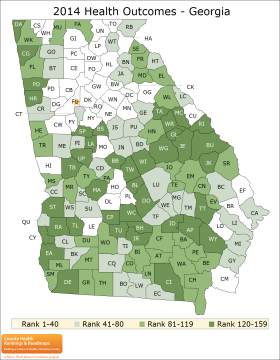Once again, suburban counties are the healthiest in Georgia, while rural counties remain the least healthy, according to a 2014 ranking released Wednesday.
Forsyth is ranked the healthiest county in Georgia in 2014, followed by Fayette, Oconee, Gwinnett, and Cherokee. The rankings were reported in the fifth annual County Health Rankings, from the Robert Wood Johnson Foundation and the University of Wisconsin Population Health Institute.
The same five counties were also at the top, and in the same order, in the 2013 rankings. All are in the northern or north-central part of the state, and all are in the Atlanta metropolitan area except for Oconee, which is in the Athens metropolitan area.
Numbers 6 through 10 in the 2014 county rankings are Cobb, Columbia, Morgan, Coweta and Rockdale.
The five counties in the poorest health, starting with least healthy, are Clay, Taliaferro, Warren, Stewart and Turner.
Clay, in southwest Georgia along the Alabama line, was also ranked last among Georgia’s 159 counties in the 2013 rankings.
Stewart County was also in the bottom five last year. The county lost its lone hospital last year due to financial trouble. It was one of four to close in Georgia in the past two years.
Mainly due to these closings — and the threat of others shutting down — rural health care emerged as a major issue in the recently completed state General Assembly session.
Gov. Nathan Deal recently announced a change in rules and licensure to help struggling rural hospitals remain open through downsizing, and to reopen newly closed facilities.
The County Health Rankings rate the overall health of nearly every county in all 50 states. The listing reflects how counties are doing on 29 factors that influence health, including smoking, obesity, high school graduation rates, employment, physical inactivity, and access to healthy foods.
The contrast between counties can be stark.
In Clay County, for example, one in three adults is obese, as compared to 28 percent of Georgians overall; more than half of its children are living in poverty, versus a state average of 27 percent. Clay also has a high teenage birth rate, and a lower ratio of primary care doctors per capita than the Georgia average.
Meanwhile, Forsyth County has fewer adults who smoke and a lower rate of obesity than the state average. The county’s unemployment rate, and percentage of uninsured, are much lower than the average for Georgia.
Marsha Davis, associate dean at the University of Georgia’s College of Public Health, said Wednesday that suburban counties have greater access to health care, healthy food and physical activity opportunities than rural areas.
“Throughout Georgia, chronic disease and health risk factors like smoking, physical inactivity and access to health care are significant public health issues,’’ Davis said. “Most striking is that health outcomes and factors affecting our health differ widely through the state.”
To close the gaps between counties, she added, the state’s public health system needs to be strengthened.
The authors of the report said that nationally, this year’s rankings show that people living in the least healthy counties are twice as likely to have shorter lives as people living in the healthiest counties. Unhealthy counties also have twice as many children living in poverty and twice as many teen births as the healthiest counties.
This year’s rankings feature several new measures including housing, transportation, and access to mental health providers.
“The County Health Rankings show us how health is influenced by our everyday surroundings—where we live, learn, work, and play,” said Bridget Catlin, director of the County Health Rankings. She added that the listings “often provide the spark for businesses, community planners, policymakers, public health, parents and others to work together for better health.”

